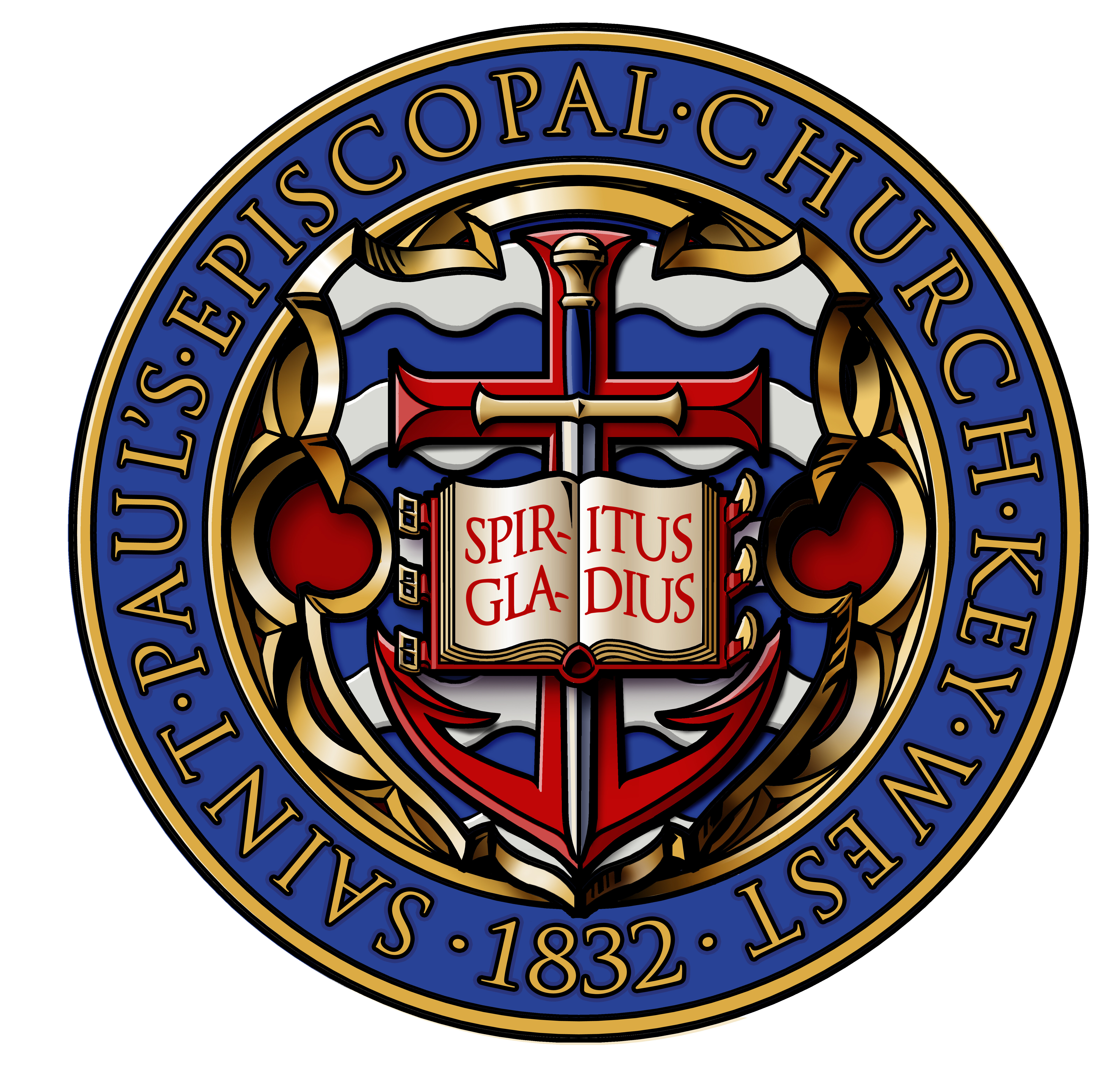Funerals
Christian Burial at St. Paul’s
The liturgy, therefore, is characterized by joy, in the certainty that ‘neither death, nor life, nor angels, nor principalities, nor things present, nor things to come, nor powers, nor height, nor depth, nor anything else in all creation, will be able to separate us from the love of God in Christ Jesus our Lord.
– An Order for Burial, The Book of Common Prayer
Burial services at St. Paul’s Episcopal Church conform with the practices of the Episcopal Church as contained in The Book of Common Prayer. Services are set as the St. Paul’s schedule allows and are held either in the nave (the main worship space), which can seat up to 450, people or in the adjoining, private Our Lady Chapel or Military Chapel, which can seat 40 people comfortably. Fees are assessed based upon the use of St. Paul’s resources, including but not limited to space rental, clergy, and music. Officiating clergy and family members of the deceased jointly plan the service. A Eucharist (Holy Communion) can take place during the service, but that is left to the discretion of loved ones and clergy planning the burial service.
At St. Paul’s, we pray for the dead because we still hold them in our love even after their death. An Episcopal funeral, therefore, is a service of worship that honors the memory of the person who died within the context of the love of God revealed in Christ. The burial service therefore centers on deep gratitude to God for the gift of a life and for the promise of eternal life in the resurrection.
Among the rituals for the Burial of the Dead in the Book of Common Prayer is that the physical body or the cremated remains of the dead be present. A coffin (if present) is to be closed before the service and covered with a pall or other suitable cover. Rarely at St. Paul’s do we have a wake here the evening before the funeral. Our burial service for the dead is one of respect, gratitude, and sacredness of life in the midst of death.
For more information, or to make an appointment with a priest, please contact us at or by calling (305) 296-5142.

Columbarium
For many generations, the burial places for human bodies were in and around the church. Then, as time passed, customs changed, restrictions were imposed and people in many cases had to be buried elsewhere. In recent times, there has been an increase in interest in cremation of bodily remains. With cremation much less space is required for burial. This has made it possible once again to return to the tradition of making one’s final resting place on the grounds of the church. Cremation is widely recognized as a theologically valid process for the deceased, and essentially is a hastening of the natural process that occurs following death. This ancient practice has particular relevance for us today, with burial in cemeteries surrounding churches less readily available. Cremation makes it possible to continue the tradition of granting a place for God’s children to “dwell in the house of the Lord forever”.
Cremation is an old tradition and has been widely practiced throughout the world from earliest times. As Christians we regard burning as a properly reverent way of disposing of objects blessed for religious use, such as prayer books, altar linens and palms. By common Christian consent, we agree that this is a reverent way of recycling that which has been set apart and used to the glory of God. Christians who favor cremation have every right or reason to cite this principle. Cremation was accepted by the Church of England and the Episcopal Church many years ago and the National Church supports cremation as an acceptable, proper, and dignified way of treating the human body at the time of death. Almost a quarter of all Americans now choose cremation over other means of burial.
In response to this need, churches have established special facilities for the care and safekeeping of cremated remains. St. Paul’s is one such church. This may be either a special garden area, a columbarium, or both. The Latin word columbarium means the dwelling place of a dove based on the Latin columba, the bird remembered in the New Testament as the symbol of the Holy Spirit. In ancient Rome, early Christians referred to their burial niches in the catacombs as columbaria, noting the resemblance to the nesting boxes provided for doves. In later years the word came to mean an area of consecrated church ground used for the burial of cremated remains.
St. Paul’s historic Memorial Garden was at one time a cemetery (churchyard) dating from antebellum times. Graves for the interment of caskets are no longer available and have not been available for some time. A memorial columbarium for the interment of cremated remains has recently been added to the historic churchyard. The maintenance of the Memorial Garden together with the graves, the few headstones and columbarium is the responsibility of the Columbarium Committee.
Interment within the grounds of St. Paul’s Church provides a link visible to us in this life between deceased Christians and their church body, enabling family and friends to pay their respects and refresh their remembrances as a part of regular worship. It is sacred ground. Such sacred ground suggests a place for quiet contemplation and reflection. Those who enter this space will feel as if they have stepped into a lush preserve, protected from the outside world by the gifts of God’s natural world.
The Memorial Garden, which includes the St. Paul’s Columbarium, is located towards the rear of the Church cemetery, behind the Church building. The columbarium is where the ashes can be placed in niches. There are two types of niches available—single and double niches. The single niches are for the interment of one person’s ashes and the double niches are for the interment of two persons’ ashes. This Garden is also a place in which to relax and enjoy the surrounding beauty.
St. Paul’s Memorial Garden is a place of many uses and facets
Beyond being a place for burial (cemetery and columbarium) and to remember the deceased, the Memorial Garden at St. Paul’s is:
- alive and dynamic with plantings, a place for the living to sit, enjoy the beauty, receive one another and share moments of hospitality, meditate, and pray;
- a place for small meetings, outdoor services, a classroom—an extension of our “indoor” church;
- in keeping with, and complements, the architecture of historic St. Paul’s Church,
- a garden that looks like it “belongs,” i.e., is a part of St. Paul’s; consistent with our rich history; a garden that will be here many years into the future;
- a place where the community should feel welcome
Fees
The fee for interment in the columbarium for members is $750 for a single niche or $1200 for a double niche. For non-members the fee is $950 for a single and $1600 for a double.
Memorial Plaque
Names and dates of persons interred in the columbarium will be on a plaque attached to the face of the niche. The marker for each niche, including all lettering and markings thereon, shall conform in all respects to standards approved by the Vestry, or the Committee. The marker must be ordered through the church. The purchaser shall pay for the actual costs of the marker (including lettering). The purchaser shall also pay for the cost related for opening and closing any niche.
Funeral Arrangements
As customary, arrangements for the funeral and burial will be made with the Rector. Cremation arrangements must be handled by a funeral home.
Reservations
Reservations may be made by contacting the church office or a Columbarium Committee representative.
What are the benefits to using a columbarium?
For church members the economic advantages are many. A niche in a columbarium is modest in cost. The columbarium is liturgically satisfying and ecologically sound. This choice invites quiet meditation and reflection and is a peaceful gathering place for families and friends.
Title and Rights
No property right of any kind will be acquired by the purchaser and legal title to all columbarium niches will be retained by St. Paul’s Episcopal Church. Permission to use a niche for burial cannot be sold or transferred to any other person without the consent of the Church. Through a signed document the purchaser must agree to the Terms and Conditions associated with purchasing a niche. Niche selection will be granted in the order in which the applications are received.
How large is a columbarium niche?
Individual single niches are 12 inches by 12 inches. They are 12 inches deep. Double niches are the same dimensions except 18 inches deep. Cremains are placed directly into the earth; urns are not used.
Would you like more information?
To discuss cremation as an option for Christian burial, contact the church office at (305) 296-5142 or fill out the form below.
